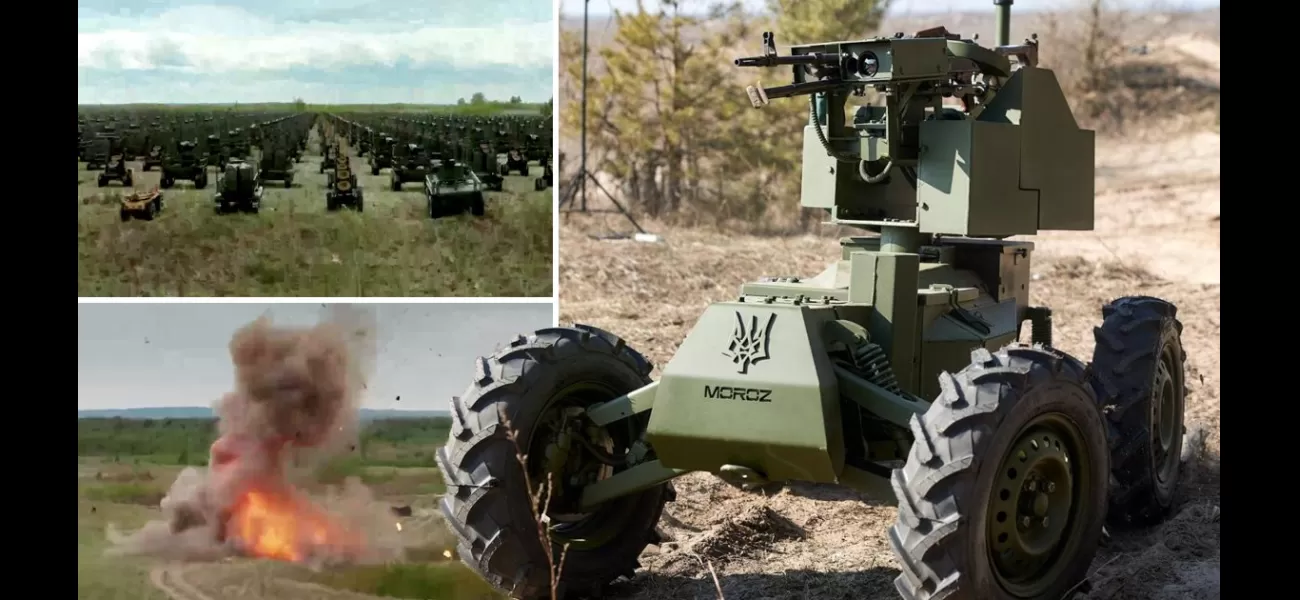Robots to assist in battle against Putin's forces alongside human soldiers.
"Modern warfare has entered a new era."
May 31st 2024.

The ongoing conflict in Ukraine has prompted the country to explore new methods of warfare, and their latest tactic is set to be a game-changer. In an effort to combat the overwhelming numbers of Russian forces, Ukraine is planning to deploy a battalion of unmanned vehicles on the battlefield. These robots, equipped with machine guns, will work alongside soldiers to defend their country against Vladimir Putin's army. It may sound like something out of a science fiction novel, but this is a very real and necessary step in modern warfare.
The idea behind these ground robots is to provide support to Ukrainian troops who are facing physical and psychological exhaustion on the frontlines. With no end to the violence in sight, these machines will assist with logistical tasks, battlefield reconnaissance, and even direct combat. They are also willing to sacrifice themselves for the most dangerous missions. This new era of warfare began in January 2024, and it's a significant advancement in Ukraine's defense strategy.
Ivan Stupak, a former officer in the Security Service of Ukraine and now an adviser to the parliament's national security, defense, and intelligence committee, explained the need for these robots. He stated that the soldiers and volunteers on the frontlines are facing increasingly difficult challenges due to the vast difference in numbers between Russia and Ukraine. With a population of 144 million versus 37 million, Russia has a clear advantage in the war. However, Stupak hopes that these robots will give Ukraine a much-needed edge, just like the navy and aerial drones have.
President Volodymyr Zelensky launched a fundraiser for ground robots during the second anniversary of his charity UNITED24. This dedicated fundraiser is aimed at providing Ukraine with more terrestrial robotic platforms. These combat robots, called "Ironclad," are made of armor and designed to withstand small arms fire. They are similar in appearance to children's radio-controlled cars, but they are used solely for military purposes. These robots work together as a coordinated swarm, and they can be operated from up to two miles away.
There are four models of combat robots approved for use by Ukraine's Ministry of Defence - SHABLYA M2, LYUT, MOROZ, and D-11. They are equipped with powerful machine guns and can hit targets from over a mile away. Some even have thermographic cameras for night missions. However, Stupak admits that Ukraine is not yet able to produce enough of these combat robots, and they are constantly working in emergency mode. Transportation of parts, especially from China, can also be challenging. This is why the fundraiser is so crucial to the success of this initiative.
In addition to combat robots, Ukraine is also utilizing self-destructive robots and minelayers. These "kamikaze robots" are designed to destroy enemy targets, such as armored vehicles, on the battlefield. They can carry up to two anti-tank mines and travel at speeds of up to 15 miles per hour. The RATEL S robots are also used to lay mines remotely, eliminating the need for soldiers to risk their lives on the frontlines. Stupak praises these minelayers for their simplicity and safety, although they are vulnerable to Russian electronic warfare.
Logistics robots, such as Volia-E, Ratel H, Termit, Rys Pro, KNLR-E, and Sirko-S1, are also an essential part of Ukraine's army of robots. They are responsible for bringing ammunition to military positions and installing electronic warfare. These machines are also capable of evacuating wounded personnel from the frontlines, with a maximum carrying capacity of 600kg. This is a crucial task that can save the lives of many soldiers.
In conclusion, Ukraine's use of robots in warfare is a significant development that has the potential to change the tide of the ongoing conflict. With their ability to provide support, carry out dangerous missions, and protect soldiers' lives, these machines are proving to be invaluable on the battlefield. While there are still challenges to overcome, such as production and transportation, the future is now in Ukraine, and it looks promising with the help of these advanced combat robots.
The idea behind these ground robots is to provide support to Ukrainian troops who are facing physical and psychological exhaustion on the frontlines. With no end to the violence in sight, these machines will assist with logistical tasks, battlefield reconnaissance, and even direct combat. They are also willing to sacrifice themselves for the most dangerous missions. This new era of warfare began in January 2024, and it's a significant advancement in Ukraine's defense strategy.
Ivan Stupak, a former officer in the Security Service of Ukraine and now an adviser to the parliament's national security, defense, and intelligence committee, explained the need for these robots. He stated that the soldiers and volunteers on the frontlines are facing increasingly difficult challenges due to the vast difference in numbers between Russia and Ukraine. With a population of 144 million versus 37 million, Russia has a clear advantage in the war. However, Stupak hopes that these robots will give Ukraine a much-needed edge, just like the navy and aerial drones have.
President Volodymyr Zelensky launched a fundraiser for ground robots during the second anniversary of his charity UNITED24. This dedicated fundraiser is aimed at providing Ukraine with more terrestrial robotic platforms. These combat robots, called "Ironclad," are made of armor and designed to withstand small arms fire. They are similar in appearance to children's radio-controlled cars, but they are used solely for military purposes. These robots work together as a coordinated swarm, and they can be operated from up to two miles away.
There are four models of combat robots approved for use by Ukraine's Ministry of Defence - SHABLYA M2, LYUT, MOROZ, and D-11. They are equipped with powerful machine guns and can hit targets from over a mile away. Some even have thermographic cameras for night missions. However, Stupak admits that Ukraine is not yet able to produce enough of these combat robots, and they are constantly working in emergency mode. Transportation of parts, especially from China, can also be challenging. This is why the fundraiser is so crucial to the success of this initiative.
In addition to combat robots, Ukraine is also utilizing self-destructive robots and minelayers. These "kamikaze robots" are designed to destroy enemy targets, such as armored vehicles, on the battlefield. They can carry up to two anti-tank mines and travel at speeds of up to 15 miles per hour. The RATEL S robots are also used to lay mines remotely, eliminating the need for soldiers to risk their lives on the frontlines. Stupak praises these minelayers for their simplicity and safety, although they are vulnerable to Russian electronic warfare.
Logistics robots, such as Volia-E, Ratel H, Termit, Rys Pro, KNLR-E, and Sirko-S1, are also an essential part of Ukraine's army of robots. They are responsible for bringing ammunition to military positions and installing electronic warfare. These machines are also capable of evacuating wounded personnel from the frontlines, with a maximum carrying capacity of 600kg. This is a crucial task that can save the lives of many soldiers.
In conclusion, Ukraine's use of robots in warfare is a significant development that has the potential to change the tide of the ongoing conflict. With their ability to provide support, carry out dangerous missions, and protect soldiers' lives, these machines are proving to be invaluable on the battlefield. While there are still challenges to overcome, such as production and transportation, the future is now in Ukraine, and it looks promising with the help of these advanced combat robots.
[This article has been trending online recently and has been generated with AI. Your feed is customized.]
[Generative AI is experimental.]
0
0
Submit Comment





